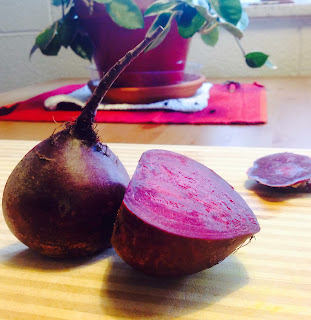In my opinion, beets are one of Nature's most wonderful masterpieces. The deep crimson-magenta color nourishes my sense of sight almost as much as the antioxidants it contains nourish my body. Tom Robbins captures the unique and complex character of the beet in his novel Jitterbug Perfume:
"The beet is the most intense of vegetables. The radish, admittedly, is more feverish, but the fire of the radish is a cold fire of discontent not of passion. Tomatoes are lusty enough, yet there runs through tomatoes an undercurrent of frivolity. Beets are deadly serious. Slavic peoples get their physical characteristics from potatoes, their smoldering inquietude from radishes, their seriousness from beets. The beet is the melancholy vegetable, the one most willing to suffer. You can't squeeze blood out of a turnip... The beet is the murderer returned to the scene of a crime. The beet is what happens when the cherry finishes with the carrot. The beet is the ancient ancestor of the autumn moon, bearded, buried, all but fossilized; the dark green sails of the grounded moon-boat stitched with veins of primordial plasma; the kite string that once connected the moon to the Earth now a muddy whisker drilling desperately for rubies. The beet was Rasputin's favorite vegetable. You could see it in his eyes."
(If you haven't read this book, I highly recommend you get your hands on a copy as soon as possible.)
Health Benefits of Beets:
-Acts as a blood purifier-Rich in calcium, iron, magnesium, phosphorus, carotene, B-complex and vitamin C
-Moistens the intestines and beneficial for overall digestive health
-For women, it promotes menstruation
-When the raw juice of the beet is combined with the juice of spinach and aloe vera, it can aid in dissolving ovarian cysts
-Improves circulation
Borsht
This is my recipe for Borsht. It's not very traditional, only in the sense that it is a soup made with beets. I love this recipe because it's easy and showcases the vegetable's beautiful red color and grounding earthy taste.
This borsht recipe is perfect for the fall as beets are in season and are available at most farmers markets and CSAs around the country. I developed this recipe while living in NYC after Hurricaine Sandy devastated much of the land of the CSA farm from which we received our vegetables. For weeks we only received brown paper bags of beets and potatoes. And for weeks I experimented with incorporating these vegetables into our meals.....
1/2 of a large onion (diced)
4 cloves of garlic (razor-thin sliced)
2 medium-sized beets (sliced thin and cut into half moons)
2 medium-sized russet potatoes (sliced thin and cut into half moons)
3 cups of roughly chopped cabbage
1 cup of thinly sliced cauliflower (or another cup of cabbage)
3 Tablespoons of butter or grapeseed oil
1/4 cup of red wine vinegar
6-8 cups of chicken or vegetable broth (homemade is best)
2 Tablespoons or more of fresh dill
Sea salt and black pepper to taste
1 teaspoon of cumin powder or cumin seed
Greek yogurt or sour cream
Heat a large cast iron pot and add butter/oil. Cook onions on medium heat until translucent. Add a dash of salt and the cumin and cook for another 2 minutes. Add the potatoes to the pot and cook while stirring occasionally for 5 minutes or more. Then add the beets and continue to stir for another 5 minutes. It is important that the potatoes are cooked first and then the beets. Continue adding the vegetables one at a time at intervals of five minutes. The cabbage goes last.
After the vegetables are pretty well sauteed, add the garlic and cook for another 2 minutes. Add about 1 cup of the vegetable or chicken stock to the pot, giving it a good stir, and making sure to loosen those bits of vegetables that have stuck to the bottom of the pan so that they can mix in with the soup. Continue to add the stock until all the vegetables are completely covered by liquid. You may have some stock left over. Bring the stock and vegetable mix to a boil, lower the heat and simmer for 45 minutes to one hour. Sometime during the simmering, usually closer to the end of cooking, add the vinegar.
When finished cooking, remove the pot from the heat and add 2 Tablespoons of the fresh dill. Next, remove 1/2-1/3 of the soup from the pot and process (either in a blender, food processor, or with a hand blender). Add the processed portion of the soup back to pot with the unprocessed portion of the soup. I highly recommend this step as if makes the soup creamier and tastier and gives the soup a thicker consistency.
Serve this soup with a generous dollop of sour cream or greek yogurt, then garnish with a sprinkle of fresh dill.
*You can also add parsley in addition to or in place of the dill if you prefer.
*I like to enjoy this soup with a tablespoon of raw sauerkraut. It gives it a kick and encourages healthy digestion.
Enjoy!










